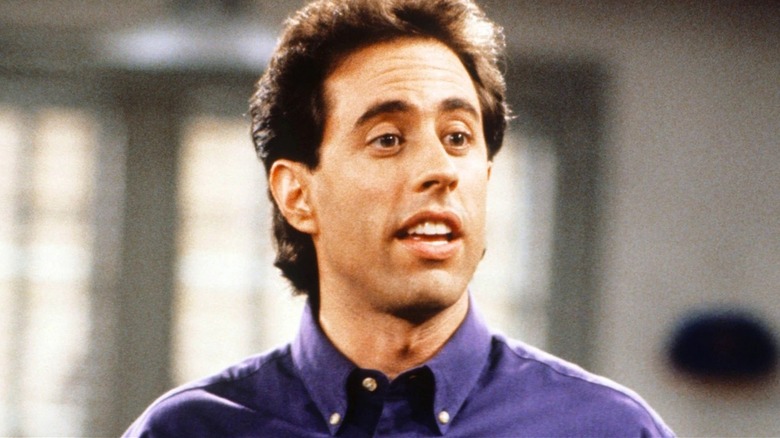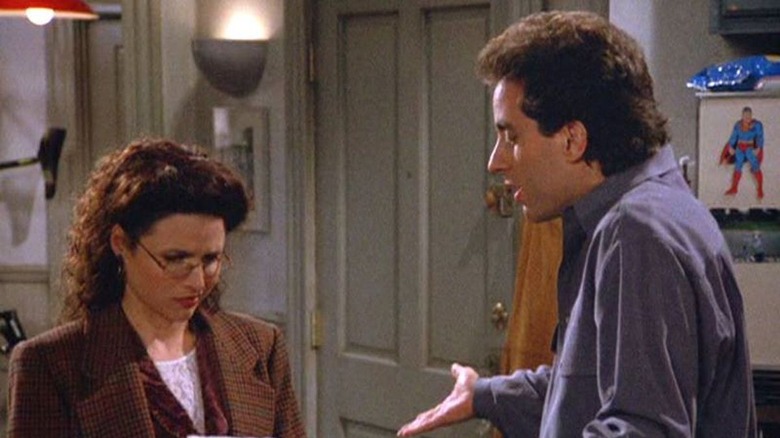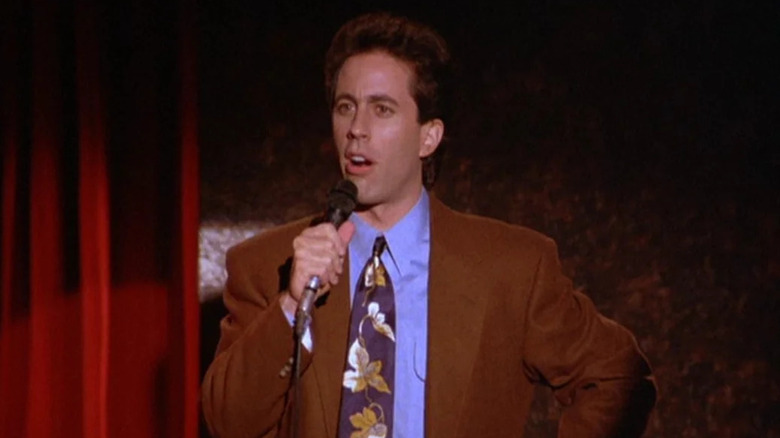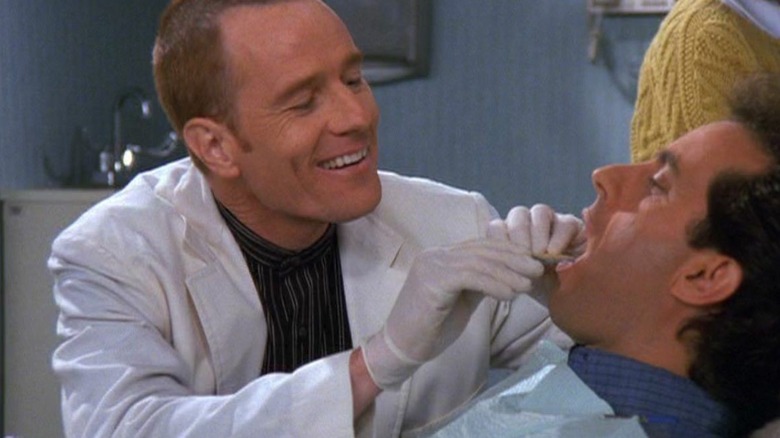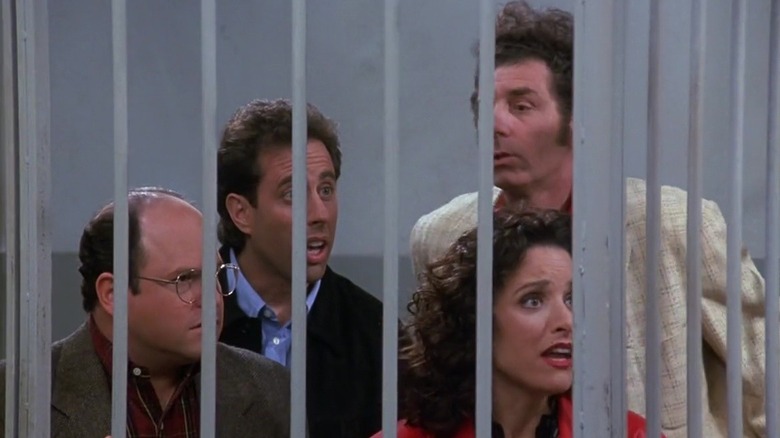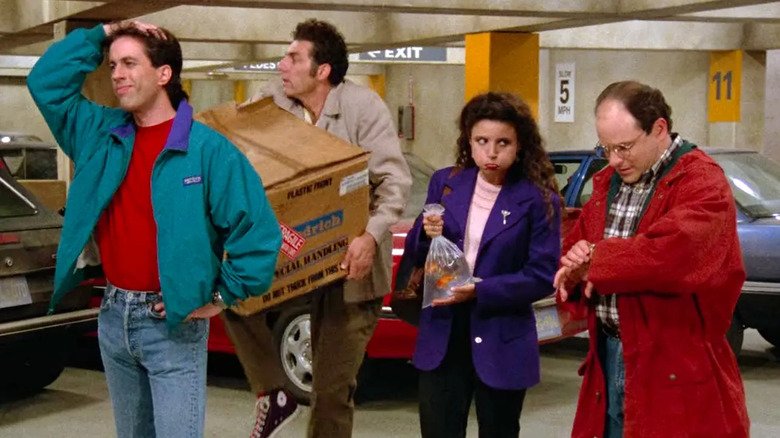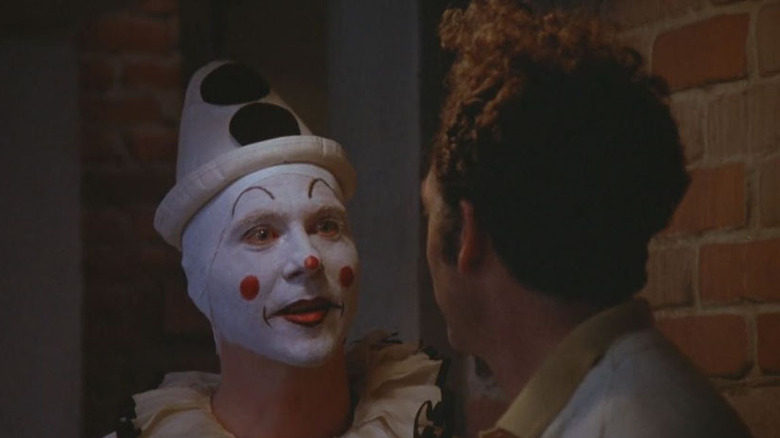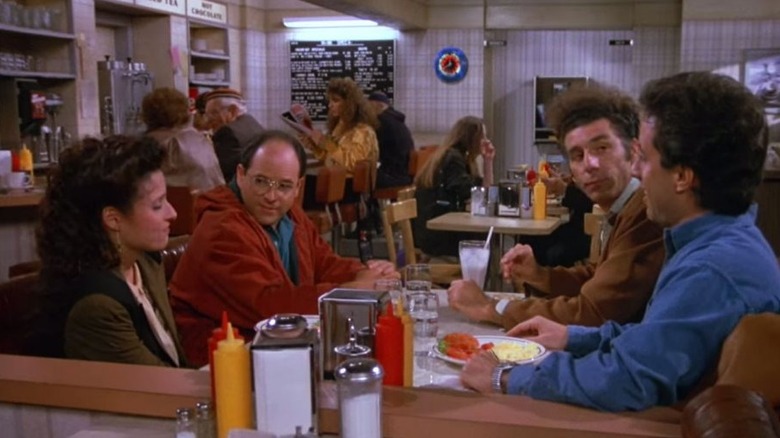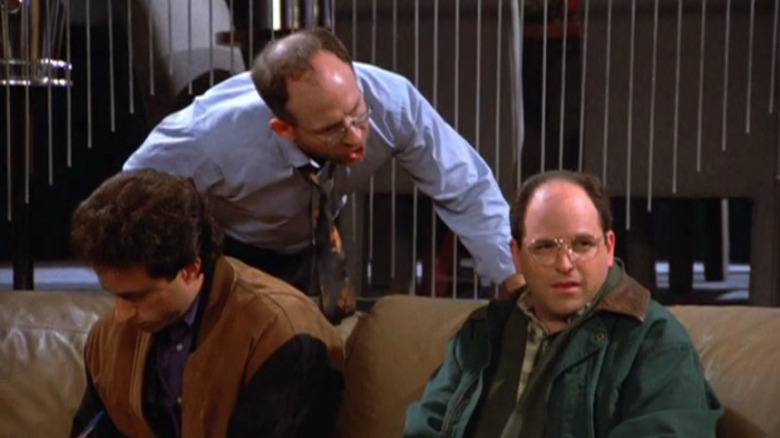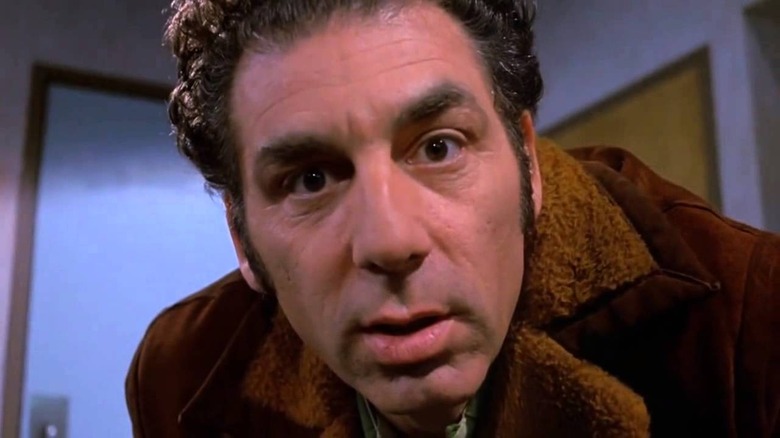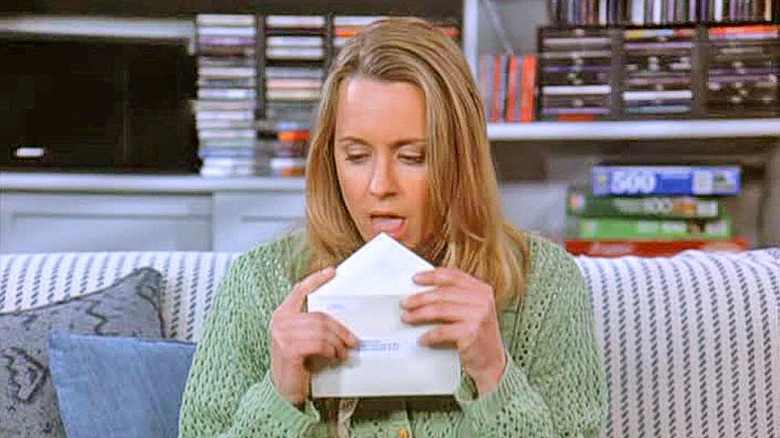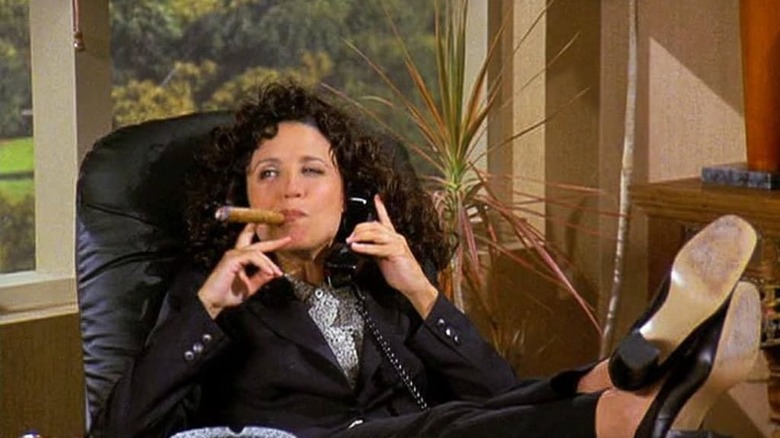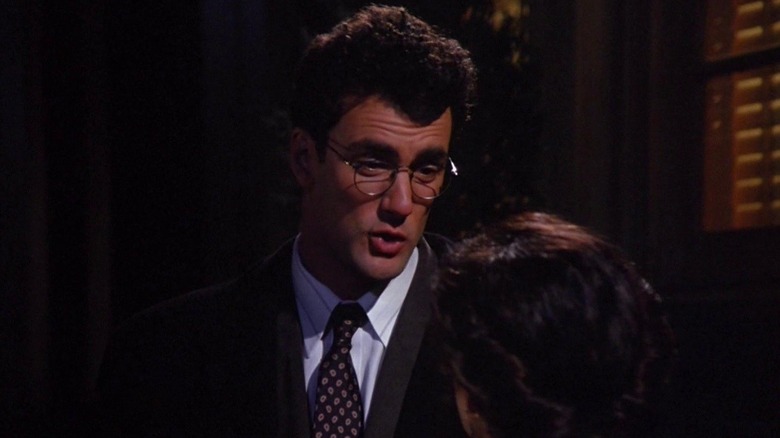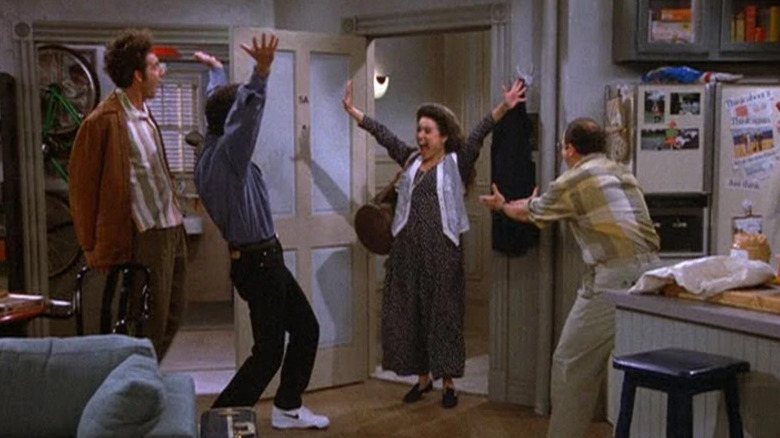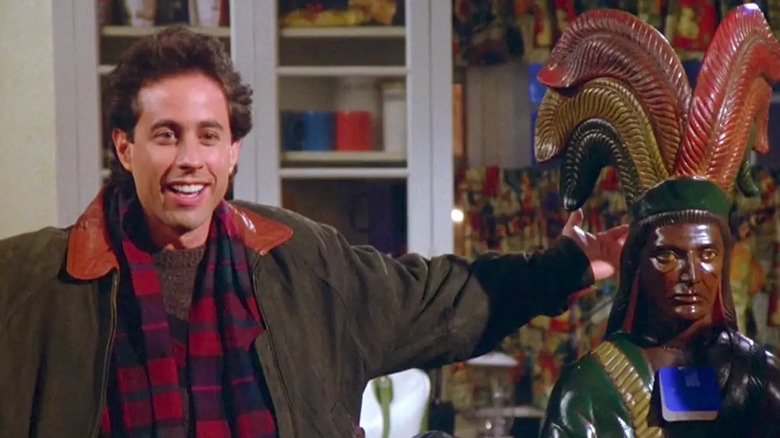The 7 Best And 7 Worst Things In Seinfeld
One of the most celebrated and enduring sitcoms of all time is "Seinfeld," created by Jerry Seinfeld and Larry David, which ran for nine seasons on NBC from 1989 to 1998. The show was led by Seinfeld as a fictionalized version of himself, joined by friends George Costanza (Jason Alexander), Elaine Benes (Julia Louis-Dreyfus), and Cosmo Kramer (Michael Richards). Following this Manhattan-residing quartet, the series was full of slice-of-life stories and zany antics that made it a hit with critics and audiences alike. However, while "Seinfeld" continues to boast a strong fan following decades after its conclusion, there are some aspects of the show that have not aged well at all upon reevaluation years later.
Here is why "Seinfeld" continues to resonate and connect with audiences today, with the secret ingredients that made it such a hilarious successful comedy series, and what aspects of the show are better left by the wayside. A nine-season run is no easy feat on television and while "Seinfeld" has one of the better track records in sitcom history, there are certainly a few clunkers that don't hold up. under further scrutiny.
Best: The show's lingo and catchphrases became iconic
The breadth of quotable jokes and long-running references through "Seinfeld" is really nothing short of extraordinary, with the show's lingo bleeding into the casual American lexicon. From Elaine brushing over minor (or not so minor) narrative details with the dismissive phrase "yadda, yadda, yadda" to George demanding "serenity now," the vernacular influence of "Seinfeld" cannot be overstated. This distinction continues decades after the 1998 series finale as a testament to the show's enduring cultural relevance and longevity.
What makes "Seinfeld's" impact so noteworthy is that it never overused its own catchphrases, exercising just enough restraint to keep them feeling fresh. Monikers like "a close talker" or "man hands" were only verbally deployed a handful of times, but visual cues would underscore its meaning. The lingo coined by the show is so universally relevant and subtle that people casually dropping "Seinfeld" references may not even be conscious that they're directly quoting the sitcom.
Worst: The alternate Seinfeld theme with lyrics
"Seinfeld" has one of the most distinct musical themes of all time with its jangling bass line and jaunty synthesized brass flourishes. Composed by Jonathan Wolff, variations on this theme played over each episode's opening and closing, along with the occasional punctuative addition to mark commercial breaks or scene transitions. However, the third season premiere attempted to mix up the established formula by utilizing an alternate theme that included lyrics.
Solely heard in the episode "The Note," this alternate theme features a female singer providing scatting vocals in the opening scene, commercial break transitions, and closing credit sequence. The altered arrangement was suggested to Wolff by Seinfeld himself, who wanted to punch up the music moving into Season 3, with both he and David liking the change. However, the network and production company were not on board with the change and had the series revert to its original theme after the Season 3 premiere aired.
Best: The show effectively uses its many guest stars
While the "Seinfeld" core cast successfully carried the series for nine seasons, the show also featured an impressive line of guest stars across its run. From beloved character actors being given memorable recurring roles to one-off appearances by actors who went on to their own celebrated careers, "Seinfeld's" rotating cast was highly talented. Fortunately, the show often knew how to most effectively utilize its guest stars, rather than wasting them on material that didn't lean into their natural appeal.
Years before starring on "Malcolm in the Middle" or "Breaking Bad," Bryan Cranston appeared five times on "Seinfeld" as Elaine's dentist boyfriend Tim Whatley, who had his own contentious dynamic with Jerry. Jerry's numerous love interests over the course of the series similarly paired well with the episodic antics, with Teri Hatcher and Janeane Garofalo among the standouts who more than kept up with the comedy. Even Marisa Tomei got in on the fun, playing a fictionalized version of herself who memorably hit things off with George before learning the extent of his antisocial tendencies.
Worst: The series finale is little more than an extended clip show
On May 14, 1998, over 76 million households in the United States tuned in to watch the last episode of "Seinfeld." However, despite the finale's impressive viewership total, critics and audiences alike were decidedly less than positive about "The Finale." Over two decades later, reception to the episode remains mixed, with Seinfeld himself expressing disappointment that it failed to live up to lofty expectations.
Originally airing as a single, hour-long episode before being split into two parts for syndication, "The Finale" has Jerry and his friends arrested after mocking a man being mugged rather than helping him. As the quartet stands trial, familiar faces from their past give their testimonies, recounting just how awful the four defendants actually are. While it's enjoyable to see fan-favorite recurring characters and guest stars from seasons past, "The Finale" closes out "Seinfeld" with what basically constitutes a glorified clip show.
Best: The show calls out the humor in everyday situations
Jerry's standup comedy routines often set the stage for many "Seinfeld" episodes. His analysis of true-to-life foibles and banal observations are particularly humorous, with a modern sensibility that's still (mostly) relevant today. More than just serving as a reminder of Jerry's career, these sequences also showcase the type of comedy that "Seinfeld" excels in, beyond the standup stage. This is all to say, the humor in "Seinfeld" is watching the main characters find themselves in awkward situations that are relatively commonplace and seeing how they react.
From searching a parking garage for one's car to a lengthy wait for a table at a Chinese restaurant, "Seinfeld" works best when it stays relatable and grounded. There are certainly instances when "Seinfeld" becomes a bit outlandish with some of its episodic premises, but it remembers to keep at least one foot planted firmly in real-world observational comedy. This sensibility has not only endeared "Seinfeld" to millions of fans worldwide but helped the show maintain its relevance decades after its run ended in 1998.
Worst: Crazy Joe Davola is more unsettling than funny
One recurring character who never quite gelled with the rest of the cast or the show's overarching comedic sensibilities is Crazy Joe Davola (Peter Crombie). Introduced in the Season 4 episode "The Pitch," Joe was a writer who clearly suffered from mental health issues that made him a risk to those around him. Quickly forming a violent grudge against Kramer and Jerry, Joe proved to be more of an uncomfortable addition to the show rather than a comical one, bucking the series' tone.
Appearing in six episodes across Season 4, Joe menaced Jerry and his friends, left threatening phone messages, took pictures of Elaine while stalking her, and resorted to physical violence on multiple occasions. Joe is last seen attempting to attack Jerry during the filming of his planned sitcom in "The Pilot" and is presumably arrested. Genuinely unsettling, Joe long overstays his welcome and is an ineffective way to bring a sense of peril into "Seinfeld" throughout its fourth season.
Best: The writing is tight and effortlessly hilarious
While the main plots of many "Seinfeld" episodes are hilarious in their own right, the show's writing, from top-to-bottom, is some of the sharpest in sitcom history. Some of the funniest scenes in the series' history aren't the larger, more ambitious schemes that Jerry and his friends get into but rather their routine conversations amongst themselves. Whether the gang is hanging out at their usual booth in Monk's Diner or passing time in Jerry's apartment, the writing remains engaging and funny for these conversation-driven sequences.
The comedic quality in the writing is apparent even in the more offhand moments, with a passing remark and action — like Elaine casually crushing a beer can on Jerry's counter — completely stealing the scene. Much of this has to do with the cast's performance and natural chemistry, but David and the rest of the writing team are experts in finding the humor in the quieter moments where the punchlines aren't anticipated. Audiences tune in for the big gags and premises but the writers know how to get big laughs from even the seemingly smallest of jokes.
Worst: George and Jerry ogling a teenager
The main characters of "Seinfeld" have done plenty of morally questionable things over the years; in many ways, the show is an exploration of their petty and underhanded tendencies and outlook. However, not all of the gags and faux pas have aged particularly well, with one of the more egregious taking place in the Season 4 episode "The Shoes." As Jerry and George meet with NBC network executive Russell Dalrymple (Bob Balaban) to pitch their sitcom idea, Russell is visited by his daughter Molly (Denise Richards).
What follows is a supremely awkward moment where Jerry motions to George to check out Molly's daughter, despite the girl being a teenager, with Russell catching George ogling his daughter. Russell understandably moves to cancel any further association with the two men, before being coaxed back into business by a suggestively clad Elaine. While played for laughs and in keeping with George's generally scummy character, a gag centered around two men uncomfortably observing a teenage girl was better left on the cutting room floor.
Best: Kramer offers a modern update on classic slapstick
If there was ever a breakout character from "Seinfeld," it was Jerry's unconventional neighbor and friend Cosmo Kramer, played by Michael Richards. Often sliding into Jerry's apartment uninvited to raid the fridge and pantry while offering his own bizarre commentary on the proceedings, Kramer added irresistible eccentricity to the show. Richards went on to earn three Emmy Awards for his much-beloved performance. Richards observed that he felt the character took over his acting. That the character of Kramer was inspired by Seinfeld and David's real-life friend Kenny Kramer somehow just makes the role even better.
Much of Kramer's humor is informed by physical comedy, from his jerky movements to the unusual sound effects he made. Kramer's specific brand of comedy and odd mannerisms hark back to the classic slapstick era popularized by comedy teams like The Three Stooges and Abbott & Costello, updated for modern audiences. Though such a cartoonish character may have seemed out of place in a sitcom setting, Richards made Kramer a key pillar of the show's enduring appeal.
Worst: Killing off Susan remains a controversial decision
After dating her on and off since Season 4, George decided to propose to his girlfriend Susan Ross (Heidi Swedberg) in the Season 5 premiere "The Engagement," with Susan accepting. George had second thoughts about his impending wedding almost immediately, with much of Season 5 leading up to the nuptials. Tragedy struck, however, when Susan died from licking the toxic glue on the cheap envelopes George bought for their wedding invitations, passing away in the Season 5 finale.
While played off as a decidedly dark joke, the decision to kill off Susan remains one of the show's more controversial narrative choices years later. Looking back on the decision, Alexander explained that he, Seinfeld, and Louis-Dreyfus felt their comedic sensibilities clashed with Ross and that they lacked chemistry with her, leading to the decision to definitely kill her off. This explanation was not well-received by the fans, prompting Alexander to issue an apology and clarification of his public comments online.
Best: Elaine is a hilarious television trailblazer
Julia Louis-Dreyfus' performance as Elaine Benes came at a time when female characters on sitcoms and other major television programs were largely relegated to the role of love interest. The comedic flourishes that Elaine's contemporaries often possessed weren't as self-effacing as their male counterparts, limiting the range of comedy available to them. Early in the series, Elaine did have a romance with Jerry, but this was quickly shelved to make Elaine a much more autonomous and interesting character, making Louis-Dreyfus something of a television pioneer.
Elaine could get just as embarrassingly debased and humiliated comedically as her male counterparts, from awkward dance moves to the string of difficult moments in her professional career. There was a sense that Elaine was one of the guys, more than able to hold her own with the others' banter and give it right back. Louis-Dreyfus' quietly groundbreaking and always hilarious work on "Seinfeld" would receive widespread critical acclaim and fan support, earning the actor an Emmy for her performance.
Worst: The show's treatment of queer characters is problematic
One of the more problematic aspects of "Seinfeld" that is especially apparent years after the show has gone off the air is its treatment of queer characters and subject matter. Though "Seinfeld" made great strides in comparison to its contemporaries in addressing social matters, even going as far as to win a GLAAD Award in 1994, certain elements have not aged well. This awkward handling of queer representation and social commentary is particularly evident in the Season 6 episode "The Beard."
After going on a platonic date with a homosexual man named Robert (Robert Mailhouse) to conceal his queer identity from his boss, Elaine becomes determined to convert Robert into a heterosexual partner. Though Elaine ultimately fails in this attempt and Robert remains steadfastly homosexual, the episode's entire premise is an uncomfortable one in the wake of conversion therapy and other homophobic initiatives. Given the GLAAD Award-winning episode "The Outing," the show had a level of self-awareness about avoiding homophobia; it just didn't always stick the landing in that noble endeavor.
Best: The show has one of television's best ensemble casts
Across nine seasons of television, the biggest constant in the quality behind "Seinfeld" is the sheer strength of its core cast, both individually and how they play off of each other. While the show bears Jerry Seinfeld's name and places the standup comedian front and center of most storylines, the show would not have worked without its perfectly balanced ensemble. Between Jerry and George's banter about such seemingly mundane topics as button placement, Elaine's sardonic wit, and Kramer's out-of-left-field insights, "Seinfeld" works best when it brings this quartet together on-screen.
Each member of the "Seinfeld" cast is funny enough in their own right alone, but working in tandem, they are better than the sum of their parts. Their rapid-fire dialogue flows seamlessly, each line coming in perfectly timed and naturally reacting to each other in a given scene. The reason why scenes set in Jerry's apartment and Monk's Cafe are so memorable isn't because of the settings themselves but because those scenes are where the cast worked together the most often and effectively.
Worst: The racial humor has especially aged poorly
The most consistently problematic aspect of "Seinfeld" that has arguably aged the poorest in retrospect is its various instances of racial humor. There is a degree of self-awareness with many of these jokes to help mitigate the cultural insensitivity but there are also instances when the humor feels forced and especially questionable in taste. While these gags often underscore how self-centered and oblivious the main characters are, some of the jokes used for cheap laughs based on race are among the show's most unfortunate.
One of the most uncomfortable episodes involving racial humor is the Season 5 episode "The Cigar Store Indian," with Jerry presenting the eponymous object as a gift to Elaine amidst a culturally insensitive caricature. Making the incident all the more unpleasant is that Jerry does this in front of Elaine's Native American friend Winona (Kimberley Norris). Other infamous, racially tinged incidents on the show include Kramer buying Dominican laborers and putting them to work in a cigar-making sweatshop in "The English Patient" and Jerry confessing a fetish for Asian women in "The Chinese Woman."
